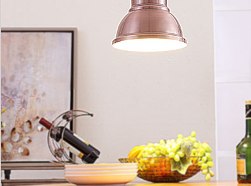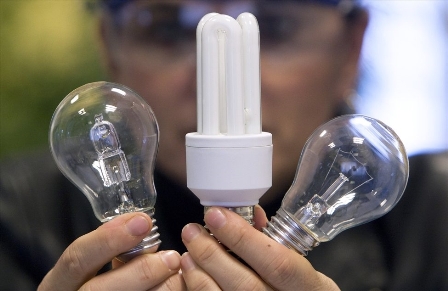Categories: Featured Articles » Sharing experience
Number of views: 23198
Comments on the article: 2
Choosing the type of lamp for domestic lighting - which is better for health?
 When comparing lamps for domestic lighting, considering their advantages and disadvantages, in most cases only the material side is considered - that is, how reliable this or that lamp is compared to others and how economical it is. At the same time, the most important selection criterion is missed - harmlessness to health, especially for human vision. In this article, we will consider which lamps are the safest for human health, which parameters should be considered when choosing one or another type of lamp.
When comparing lamps for domestic lighting, considering their advantages and disadvantages, in most cases only the material side is considered - that is, how reliable this or that lamp is compared to others and how economical it is. At the same time, the most important selection criterion is missed - harmlessness to health, especially for human vision. In this article, we will consider which lamps are the safest for human health, which parameters should be considered when choosing one or another type of lamp.
Color rendering of lamps and its effect on human vision
When choosing light sources, first of all, you should pay attention to the correct color rendering of the lamp. This concept refers to the display in natural tones of various colors.
The tallest color rendering coefficient for incandescent lamps, halogen lamps, as well as for certain types of compact fluorescent lamps with a five-component phosphor. The color rendering coefficient of LED lamps, fluorescent lamps with a three-component phosphor is slightly lower.
In this case, it is impossible to unequivocally answer that the LED lamp or compact fluorescent has good color reproduction. If a halogen lamp or an incandescent lamp, regardless of the manufacturer, has approximately the same color rendering level - high, then in the case of an LED lamp or a compact fluorescent lamp, their color rendering depends on the design features, manufacturing technology, and the quality of the materials used.
In this regard, low-quality fluorescent and LED lamps with unnatural color reproduction for the human eye, that is, a low color rendering coefficient, are often found.
If the lamp distorts the color rendition, then this negatively affects vision, causes some discomfort, eyes get tired faster. In this case, the more time a person spends indoors, the more harm these light sources do to him. If a person is in a room where these lighting elements are installed for a negligible amount of time, then there will be no harm from such lamps.
That is, if we consider a specific situation - the choice of lamps in different rooms of an apartment, then such a lamp can be used without harm to illuminate a bathroom, toilet, living room, in bedrooms - in those places where a person, as a rule, is not long and does not perform any or work causing eye strain.

The incandescent and halogen lamps in this case have a significant advantage - they are characterized by the correct color rendition. These lamps are the safest for human sight. Such lamps are recommended for use in those rooms where a person spends the greatest amount of time, where he performs various tasks.
Still there are high-quality fluorescent and LED lamp, which have a high color rendering coefficient, so if there is an exact confidence in their quality, their manufacturer has a good reputation, then you can give preference to these lamps. Both the LED lamp and the housekeeper can emit different light, you can choose a more suitable one. Below we will talk about this in more detail.
Light temperature of lamps, quality of luminescence
There is another characteristic of the color rendering of lamps - light temperature or color, measured in Kelvin, which is usually indicated by manufacturers on lamps.
An incandescent lamp and a halogen lamp emits warm white light, corresponding to a light temperature of up to 3300 K.Fluorescent lamps and LED lamps mainly have a light temperature in the range of 2700-7000 K. The higher this value, the colder the light.
Certain types of housekeepers and LED lamps are characterized by a luminescence that is close to natural daylight; the light temperature of such lamps is in the range of 6200-6500 K. That is, in fact, you can choose a lamp with any value of luminous flux: for lovers of warm white light with a lower light temperature, for cold and daylight - closer to the maximum mark.
When choosing lamps, it should be borne in mind that at different times of the day a person will have a comfortable different temperature of light. If during the day the lamp of a cold, daylight glow is perceived normally by the human eye, then in the evening such a glow will disrupt the functioning of the body’s natural biological clock. In the evening, it is better to give priority to lamps that emit warm, white light. In everyday life, lighting is used continuously in the evening, so it is recommended to give preference to lamps with a warmer glow.
Also worth mentioning is a characteristic such as light uniformity. An incandescent lamp and a halogen lamp without a diffuser emits an uneven luminous flux.
The source of light in this case is a point source - a filament that shines very brightly and when looking at the lamp negatively affects the eyes, in particular the retina. The light in the room is also uneven, in some areas darker, in some brighter. LED and fluorescent lamps in this case have an advantage - they are characterized by a uniform glow, the light is distributed evenly throughout the room.
The unevenness of the glow of incandescent lamps and some types of halogen is compensated by reflectors and diffusers (shades), which ensure uniform distribution of the glow of the lamps throughout the room.
As for the glow, compact fluorescent lamps are not recommended for people with photosensitive skin, since these lamps emit more intense light with a high level of ultraviolet radiation.
Some housekeepers have special protective shields that can reduce the level of ultraviolet radiation. But due to the fact that the level of magnetic and ultraviolet radiation cannot be felt, it is not impossible to say exactly which lamp is safer and which is not. Therefore, it is recommended that these lamps be placed no closer than 60 cm to the body. That is, such lamps are suitable for lighting a room, while for table and other lamps located in close proximity to a person, such lamps are not recommended.

Environmental friendliness of lamps and safety of their operation
The issue of environmental friendliness of lamps, namely the content of harmful components in their design is also very important. If color rendering has an effect on human vision, then the harmful substances contained in the lamp can harm the whole body.
A fluorescent lamp is the most dangerous of all types of lamps. Structurally, it contains a certain amount of mercury - a very dangerous element for health. When working, when the bulb is not broken, it does not harm itself. But at the same time, the flask itself is very fragile, often when installing or removing the flask it literally breaks up in the hands. In this case, mercury enters not only the surrounding objects and the floor in the room, but also in the form of vapors enters the respiratory tract of a person. At the same time, the danger is also caused by very small glass of an exploding flask.
In the case of several such incidents, great harm is inflicted on health, not worth the means that were saved on these lamps. And given the fact that most fluorescent lamps do not serve and a third of the stated period comes out that there is no saving in the end.
Incandescent, halogen and LED bulbs are environmentally friendly and free of harmful substances.With regard to operational safety, LED lamp is absolutely safe.
The halogen lamp and incandescent lamp become very hot during operation, therefore they can melt materials that are close, in particular the structural elements of the lamps, while emitting harmful substances. Therefore, when choosing an incandescent lamp or a halogen lamp, it is necessary to first analyze the possibility of their installation, since most of the luminaires are not designed to work with these lamps. As for the incandescent lamp, it is very rare, but still there is a situation when the bulb of the incandescent lamp flies out of the base, breaking on a hard surface, or bursting in the lamp itself.
What lamp to choose? Considering the above arguments, we can conclude that the incandescent lamp and the halogen lamp are as safe as possible for both human vision and the body as a whole. An LED lamp and a compact fluorescent lamp (housekeeper) can be safe, and can cause irreparable harm to eyesight or to health in general. Therefore, if you still have a question about choosing a LED or fluorescent lamp, then you need to approach it seriously, choosing the most reliable and safe lamp.
If there is no confidence in the quality of the products, then it is better not to risk your health and take the less economical, but the safest incandescent or halogen lamps. Especially if there is a stove about lighting a child’s workplace - weak eyesight is most susceptible to negative factors.
It should also be remembered that manufacturers seek to increase lamp sales by any means, therefore, to attract buyers, characteristics are often given that generally do not correspond to the actual parameters of the lamps. Therefore, you need to pay attention to all the nuances in the process of operating the lamps. For instance, if the lamp flickers noticeablySince its light is characterized by incorrect color reproduction, then such a lamp can not be operated, at least in those places where a person spends a lot of time.
Read more about the choice of LED lamps here:What to look for when choosing LED lamps
See also at bgv.electricianexp.com
:
